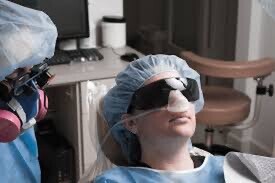How to perform Safe Mercury Amalgam Removal
2016 IABDM Recommendations for The PROTECT PROTOCOL: Safe Mercury Amalgam Removal
The room where the mercury removal is to take place needs to have adequate filtration and ventilation in place 1,2. This requires a high volume, air filtration system capable of removing mercury, as well as a negative ion generating/capturing device 3. Data suggests that one of the most important controls to this end is the use of a high vacuum mercury vapour system/device in close (1-3 inches) approximation to the operating field 4. Copious amounts of water to reduce heat and capture mercury aerosol with a conventional high speed evacuation device is required to reduce ambient mercury levels to safety standards 5. High speed evacuation produces the best capture when fitted with a Clean Up device which is suggested 2. Use of a non-latex dam is highly recommended. We recognize this may not be possible in 100% of the cases but this should be the goal.
All present (staff and patient) must be protected. The velocity of the particles generated by high speed drilling is too much to be overcome by suction devices 6,7. It has been shown that this particulate can be expected to be spread from the patient's mouth to the top of the assistant and dentist's head to the knee of the patient 2. Disposable or washable gowns and covers for the dentist, assistant and patient need be in place. These barriers should be removed and either discarded or washed after each procedure. If washed, they should be soaked in Hg-X powder before washing. Face shields if not wearing loops and hair coverings need be utilized by both the dentist and the assistant7. Additionally, either a well-sealed, respiratory grade mask rated to capture mercury or a positive pressure, well-sealed mask providing air or oxygen should be worn by all dental personnel in the room. Hg-X crème should be used before donning gloves. Non- latex gloves should be utilized8.
The patient A non-latex dam needs to be placed and properly sealed from the oral environment8. In order to cover the patient’s skin and clothing a full body, plastic-backed apron as well as a full head/face barrier beneath the dam is to be utilised 2. External air or oxygen delivered via a nasal mask is necessary to assure the patient does not inhale any mercury vapour or particulate due to the spread of mercury particulate and vapour 7.
All contaminated components need be wiped with Mercon or Hg-X and disposed of/washed when removed from the operating area 11,12. The operator needs to be aware that all objects used for the mercury removal process will continue to emit vapor so should be properly isolated2. Use of a mercury capturing wipe should be considered for all exposed surfaces at least once per day. During the opening and maintenance of suction traps in operatories or on the main suction unit, staff should utilize the appropriate personal protection equipment mentioned above.
Sources:
Ziff M, Sukel PP. Reducing Mercury Vapor Exposure for the Patient During Amalgam Removal. IAOMT Sci Rev. 2000. http://iaomt.org/members/wp- content/uploads/srReducingMercuryVaporExposureforthePatientDuringAmalgamRemoval.p df. Accessed August 24, 2015.
Palmer J, Young M. The Efficacy of the IAOMT Engineering Controls Used During Removal of Mercury Silver Dental Restorations. IAOMT Sci Rev. 2013. http://iaomt.org/members/wp-content/uploads/Efficacy-of-the-IAOMT-Engineering- Controls-Used-During-Removal-of-Hg-Restorations.24.14.doc. Accessed August 24, 2015.
Roberts JC. Reducing Mercury Vapor in the Operatory Common Breathing Space by Ion Precipitation. IAOMT Sci Rev. 2000. ) http://iaomt.org/members/wp- content/uploads/srReducingMercuryVaporintheOperatory.pdf.
Robbins D. IQAir DentalPro and DentalPro Flex-Vac Mercury Air Cleaner. IAOMT Sci Rev. 2007. http://iaomt.org/members/wp- content/uploads/srIQAirDentalProandDentalProFlex.pdf. Accessed August 24, 2015.
Warwick R, O Connor A, Lamey B. Mercury vapour exposure during dental student training in amalgam removal. J Occup Med Toxicol. 2013;8(1):27. doi:10.1186/1745-6673-8-27.
Berglund a. Release of mercury vapor from dental amalgam. Swed Dent J Suppl. 1992;85:1-52.
Nimmo A, Werley MS, Martin JS, Tansy MF. Particulate inhalation during the removal of
amalgam restorations. J Prosthet Dent. 1990;63(2):228-233.
Rego A, Roley L. In-use barrier integrity of gloves: Latex and nitrile superior to vinyl. Am J
Infect Control. 1999;27(5):405-410. doi:10.1016/S0196-6553(99)70006-4.
Division of Toxicology and Environmental Medicine Prevention R and MSBERT. Chemical- Specific Health Consultation for Joint EPA/ATSDR National Mercury Cleanup Policy Workgroup Action Levels For Elemental Mercury Spills.; 2012.
Richardson GM. Inhalation of Mercury-Contaminated Participate Matter by Dentists: An
Overlooked Occupational Risk. Hum Ecol Risk Assess An Int J. 2003;9(6):1519-1531. doi:10.1080/10807030390251010.
IABDM Executive Office:
281-651-1745
Email: https://iabdm.org/contact-us/
Mailing Address:
IABDM
19122 Camellia Bend Circle Spring, Texas 77379

